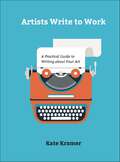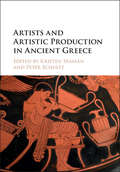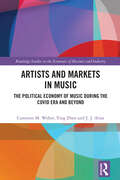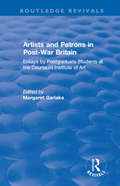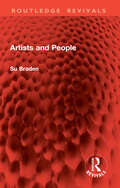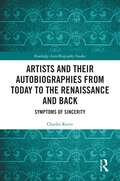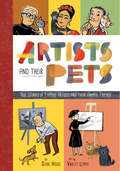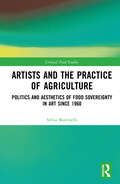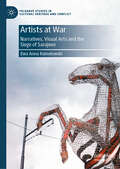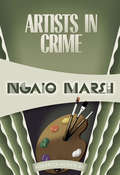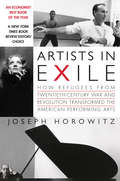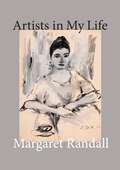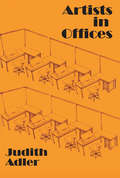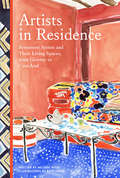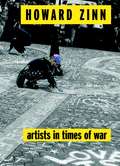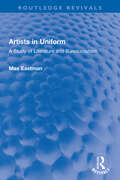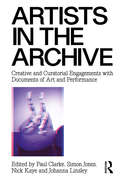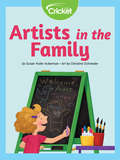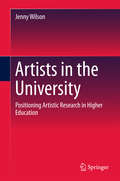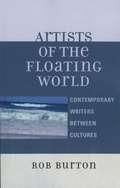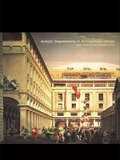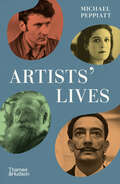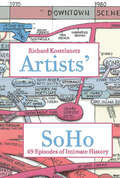- Table View
- List View
Artists Write to Work: A Practical Guide to Writing about Your Art
by Kate KramerWriting and research strategies for documents every artist must craft: letters, applications, wall text, etc.Welcoming and effective, spells out clear connections between the writing process and creative practiceDestined to become an important addition to the libraries of art students, educators, and artists
Artists and Artistic Production in Ancient Greece
by Kristen Seaman Peter SchultzGreek artists and architects were important social agents who played significant roles in the social, cultural, and economic life of the ancient Greek world. In Artists and Artistic Production in Ancient Greece, art historians, archaeologists, and historians explore the roles and impacts of artists and craftsmen in ancient Greek society. The contributing authors draw upon artistic, architectural, literary, epigraphical, and historical evidence to discuss a range of artists, architects, artistic media, and regions. They refer to historiography and modern theory, taking stock of the past while offering some new directions for future research. Incorporating a variety of methodological approaches and making use of often-neglected evidence, Artists and Artistic Production in Ancient Greece re-examines many long-held ideas and provides a deeper understanding of particular artists and architects, their works, and their social agency.
Artists and Markets in Music: The Political Economy of Music During the Covid Era and Beyond (Routledge Studies in the Economics of Business and Industry)
by Cameron M. Weber Ying Zhen J.J. AriasThis monograph is an innovative examination of the political economy of music. It integrates original economic theories and empirical research to shed light on the economic and social forces shaping music and society today. Interactive relationships, such as the importance of entrepreneurship, serendipity and authenticity, will be explored in artist subjective determinations of success. In particular, this book deeply explores the mental health of musicians and "creative destruction" during the covid era, copyrights in music markets and an evaluation of the importance of entrepreneurship and brand marketing in the life of musical artists. The monograph contributes empirical research to underexplored areas in the cultural economics of music, such as the proposed musical production function by Samuel Cameron (Routledge 2015) and the concept of distinction in cultural production by Pierre Bourdieu (Routledge 1984, 2010) as uniquely applied with examples from the covid era. Readers will benefit from this easy-to-understand interdisciplinary exploration of the music industry with a focus on the United States and the political economy of music during the covid era. Most cultural economics is focused on Europe and Asia, so this emphasis on the United States will be of interest. This book will be a beneficial reference work for researchers and will find an audience among music professionals and artists. Academics and non-academics, experts and novices interested in music and political economy will also find value in Artists and Markets in Music.
Artists and Patrons in Post-war Britain
by Courtauld Institute of ArtThis title was first published in 2001. An examination of art and patronage in Britain during the post-war years. It consists of five case studies, initially written as MA theses, that closely investigate aspects of the mechanisms of patronage outside the state institutions, while indicating structural links within it. The writers have sought to elucidate the relationship between patronage, the production of art and its dissemination. Without seeking to provide an inclusive account of patronage or art production in the early post-war years, their disparate and highly selective papers set up models for the structure of patronage under specific historical conditions. They assume an understanding that works of art are embedded in their social contexts, are products of the conditions under which they were produced, and that these contexts and conditions are complex, fluid and imbricated in one another.
Artists and People (Routledge Revivals)
by Su BradenFirst published in 1978, Artists and People examines the formal attempts by arts administrators to set up schemes for artists to work in community contexts. The experience of creative artists who have taken up ‘residencies’ in schools, libraries and art centres is contrasted with the unique forms of expression developed by local communities themselves in new towns, housing estates, rural centres, and inner cities, in areas ranging from Tower Hamlets in London, through Craigmillar in Scotland, to new towns such as Telford and Milton Keynes.The book takes the form of a series of accounts of the experiences of artists and communities who have come together in contexts not usually seen as arenas for the arts. Su Braden looks at these experiences in the light of the philosophy that the right to artistic expression is a basic human freedom for everybody, not just for ‘artists’. In writing the book she has drawn on her experience as a community arts worker and she assesses the effect of the traditional structures (the theatre, gallery and concert hall) both on the form of art itself and the critical relationship which is intrinsic to its development. By looking at the first-hand experience of artists and local people, she has documented the dependence of much contemporary art for its form and the nature of its critical relationships on the formal structure offered by traditional outlets. In contrast, the examination of the relationship between artists and communities who have developed creative forms out of a more spontaneous recognition of mutual needs and talents reveals a new perspective on the social value of liberating artistic expression from its formal restraints.
Artists and Signatures in Ancient Greece
by Jeffrey M. HurwitThe Greeks inscribed their works of art and craft with labels identifying mythological or historical figures, bits of poetry, and claims of ownership. But no type of inscription is more hotly debated or more intriguing than the artist's signature, which raises questions concerning the role and status of the artist and the work of art or craft itself. In this book, Jeffrey M. Hurwit surveys the phenomenon of artists' signatures across the many genres of Greek art from the eighth to the first century BCE. Although the great majority of extant works lack signatures, the Greek artist nonetheless signed his products far more than any other artist of antiquity. Examining signatures on gems, coins, mosaics, wall-paintings, metalwork, vases, and sculptures, Hurwit argues that signatures help us assess the position of the Greek artist within his society as well as his conception of his own skill and originality.
Artists and Their Autobiographies from Today to the Renaissance and Back: Symptoms of Sincerity (Routledge Auto/Biography Studies)
by Charles ReeveReading life writing that runs from Tracey Emin, Faith Ringgold and Judy Chicago to Marie Bashkirtseff, Benvenuto Cellini and beyond, Artists and Their Autobiographies from Today to the Renaissance and Back investigates the intriguing doubled truths of artists’ autobiographies: truth in life and truth in art; authorial truth/s and the truth of their art as they saw it. However, this book focuses specifically on the truth of sincerity, which here—following classic discussions by Reindert Dhondt, Philippe Lejeune and Lionel Trilling—appears as a truth to self that floats free from facts to link avowal and feeling. From there, this volume merges autobiography studies with a history of ideas approach to art to trace sincerity’s constancy and variability across times and cultures. Through this pre-disciplinary dialogue, this book shows that recent and historical artists’ autobiographies differ in how, not if, they intertwine sincerity in life and art. Along the way, this volume leverages the foregrounding of sincerity caused by this doubling to explore such key issues of autobiography studies as autobiography’s relation to fiction, serial autobiography, "as-told-to" narrative and what happens when liars claim to tell all.
Artists and Their Pets: True Stories of Famous Artists and Their Animal Friends
by Susie Hodge Violet LemayDid you know that the great Pablo Picasso had many pets, including a white mouse and a goat? And that Andy Warhol loved his dachshunds, Salvador Dalí liked ocelots and anteaters, and Georgia O’Keeffe had a passion for chows and Siamese cats? Artists and Their Pets tells these stories and many more with full-color illustrations and a chirpy narrative that will delight both art buffs and pet enthusiasts. Lexile: 1140L
Artists and the Arab Uprisings
by Lowell H. Schwartz Dalia Dassa Kaye Jeffrey MartiniRegional artists can play a positive role in shaping public debate and supporting democratic transition in the Middle East. This report explores the challenges artists have faced since the Arab uprisings, U. S. government programs to support arts in the region, and the wide array of nongovernmental activities to engage Arab artists, offering recommendations to improve support for these artists.
Artists and the Practice of Agriculture: Politics and Aesthetics of Food Sovereignty in Art since 1960 (Critical Food Studies)
by Silvia BottinelliArtists and the Practice of Agriculture maps out examples of artistic practices that engage with the aesthetics and politics of gathering food, growing edible and medicinal plants, and interacting with non-human collaborators. In the hands of contemporary artists, farming and foraging become forms of visual and material language that convey personal and political meanings. This book provides a critical analysis of artistic practices that model alternative food systems. It presents rich academic insights as well as 16 conversations with practicing artists. The volume addresses pressing issues, such as the interconnectedness of human and other-than-human beings, the weight of industrial agriculture, the legacy of colonialism, and the promise of place-based and embodied pedagogies. Through participatory projects, the artists discussed here reflect on the links between past histories, present challenges, and future solutions for the food sovereignty of local and networked communities. The book is an easy-to-navigate resource for readers interested in food studies, visual and material cultures, contemporary art, ecocriticism, and the environmental humanities.
Artists at War: Narratives, Visual Arts and the Siege of Sarajevo (Palgrave Studies in Cultural Heritage and Conflict)
by Ewa Anna KumelowskiThis book follows the lives of Sarajevan visual artists as they responded to the rising instability and political fragmentation that defined the last days of Yugoslavia&’s existence. Exploring how these artists understood and spoke about the onset of war, it places a focus on a series of recognizable discourses, touching upon notions of Yugoslav common culture, civilization and cultural resistance, which have since become synonymous with the memory of the siege of Sarajevo. This book hinges its central arguments on a microhistorical reading of this unique cultural community that existed simultaneously on the practical periphery of Yugoslav cultural developments and within the center of the state&’s fragmentation. In doing so, it offers a novel approach towards understanding the experiences of everyday life in besieged Sarajevo
Artists in Crime: Death In Ecstasy, Vintage Murder, Artists In Crime (Roderick Alleyn #6)
by Ngaio MarshA model is murdered in this &“first-rate&” detective story by the Mystery Writers of America Grand Master (Kirkus Reviews). On a ship traveling back to England, Miss Agatha Troy finds Inspector Roderick Alleyn tedious and dull; he thinks she&’s a bohemian cliché. They may be destined for romance, but there&’s a murder in the way: No sooner has Alleyn settled in to his mother&’s house, eager for a relaxing end to his vacation, than he gets a call that a model has been stabbed at the artists&’ community down the road. And the talented Miss Troy is one of the community&’s most prominent and outspoken members . . . &“The doyenne of traditional mystery writers.&” —The New York Times
Artists in Exile
by Joseph HorowitzDuring the first half of the twentieth century--decades of war and revolution in Europe--an "intellectual migration" relocated thousands of artists and thinkers to the United States, including some of Europe's supreme performing artists, filmmakers, playwrights, and choreographers. For them, America proved to be both a strange and opportune destination. A "foreign homeland" (Thomas Mann), it would frustrate and confuse, yet afford a clarity of understanding unencumbered by native habit and bias. However inadvertently, the condition of cultural exile would promote acute inquiries into the American experience. What impact did these famous newcomers have on American culture, and how did America affect them? George Balanchine, in collaboration with Stravinsky, famously created an Americanized version of Russian classical ballet. Kurt Weill, schooled in Berlin jazz, composed a Broadway opera. Rouben Mamoulian's revolutionary Broadway productions of Porgy and Bess and Oklahoma! drew upon Russian "total theater." An army of German filmmakers--among them F. W. Murnau, Fritz Lang, Ernst Lubitsch, and Billy Wilder--made Hollywood more edgy and cosmopolitan. Greta Garbo and Marlene Dietrich redefined film sexuality. Erich Korngold upholstered the sound of the movies. Rudolf Serkin inspirationally inculcated dour Germanic canons of musical interpretation. An obscure British organist reinvented himself as "Leopold Stokowski." However, most of these gifted émigrés to the New World found that the freedoms they enjoyed in America diluted rather than amplified their high creative ambitions.A central theme of Joseph Horowitz's study is that Russians uprooted from St. Petersburg became "Americans"--they adapted. Representatives of Germanic culture, by comparison, preached a German cultural bible--they colonized. "The polar extremes," he writes, "were Balanchine, who shed Petipa to invent a New World template for ballet, and the conductor George Szell, who treated his American players as New World Calibans to be taught Mozart and Beethoven." A symbiotic relationship to African American culture is another ongoing motif emerging from Horowitz's survey: the immigrants "bonded with blacks from a shared experience of marginality"; they proved immune to "the growing pains of a young high culture separating from parents and former slaves alike."
Artists in My Life
by Margaret RandallMargaret Randall reveals personal stories and profound insights about the artists who most influenced her life.Artists in My Life is a collection of intimate and conversational accounts of the visual artists that have impacted the renowned poet activist Margaret Randall on her own journey as an artist. Randall writes of each relationship through multiple lenses: as makers of art, social commentators, women in a world dominated by male values, and in solitude or collaboration with communities and the larger artistic arena. Each story offers insight into the artist’s life and work, and analyses the impact it had on Randall’s own work and its impact on the larger art community. The work strives to answer bigger questions about visual art as a whole and its lasting political influence on the world stage. Randalls describes her motivations: ”I go beneath the surface, asking questions and telling stories. I have wanted to answer questions such as: Why is it that visual art—drawing, painting, sculpture, photography, architecture—grabs me and, in particular instances, feels as if it changes me at the molecular level? How do art and memory interact? How do reason and intuition come together in art? Do women and men make art differently? Does great art change the viewer? Does it change the artist? How does art travel through time?”
Artists in Offices: An Ethnography of an Academic Art Scene
by Judith E. AdlerUniversities have become important sources of patronage and professional artistic preparation. With the growing academization of art instruction, young artists are increasingly socialized in bureaucratic settings, and mature artists find themselves working as organizational employees in an academic setting. As these artists lose the social marginality and independence associated with an earlier, more individual aesthetic production, much cultural mythology about work in the arts becomes obsolete.This classic ethnography, based on fieldwork and interviews carried out at the California Institute of the Arts in the 1980s, analyzes the day-to-day life of an organization devoted to work in the arts. It charts the rise and demise of a particular academic art "scene," an occupational utopian community that recruited its members by promising them an ideal work setting.Now available in paperback, it offers insight into the worlds of art and education, and how they interact in particular settings. The nature of career experience in the arts, in particular its temporal structure, makes these occupations particularly receptive to utopian thought. The occupational utopia that served as a recruitment myth for the particular organization under scrutiny is examined for what it reveals about the otherwise unexpressed impulses of the work world.
Artists in Residence: Seventeen Artists and Their Living Spaces, from Giverny to Casa Azul
by Melissa WyseArtists in Residence explores the homes of 17 legendary and contemporary artists.Readers can peek inside Georgia O'Keeffe's adobe courtyards, stroll through Henri Matisse's vibrant aviary, and peruse Jean-Michel Basquiat's collection of over 1,000 videotapes.A house or an apartment is not simply a place to eat and sleep for these artists; they transform quotidian spaces into dynamic reflections of their individual artistic preoccupations.• Offers a fascinating and inspiring blend of art history, interior design, and travel• Invites readers to peer behind the closed doors of top artists from around the world• Richly illustrated throughoutThrough vivid text and image, Artists in Residence explores how each artist's living space relates to their individual and distinct artist practice.Readers gain a deeper appreciation of their favorite artists' work, and perhaps discover a new favorite visual along the way.• This petite jacketed hardcover book makes a wonderful gift for artists and art fans everywhere.
Artists in Times of War (Open Media Series)
by Howard Zinn"Political power," says Howard Zinn, "is controlled by the corporate elite, and the arts are the locale for a kind of guerrilla warfare in the sense that guerrillas look for apertures and opportunities where they can have an effect." In Artists in Times of War, Zinn looks at the possibilities to create such apertures through art, film, activism, publishing and through our everyday lives. In this collection of four essays, the author of A People's History of the United States writes about why "To criticize the government is the highest act of patriotism." Filled with quotes and examples from the likes of Bob Dylan, Mark Twain, e. e. cummings, Thomas Paine, Joseph Heller, and Emma Goldman, Zinn's essays discuss America's rich cultural counternarratives to war, so needed in these days of unchallenged U.S. militarism.
Artists in Uniform: A Study of Literature and Bureaucratism (Routledge Revivals)
by Max EastmanFirst published in 1934, Artists in Uniform confronts what the author describes as ‘two of the worst features of the Soviet experiment’ following Lenin’s death – bigotry and bureaucratism – and shows how they have functioned in the sphere of arts and letters. It is divided into three parts: The Artist’s International; A Literary Inquisition; and Art and the Marxian Philosophy.
Artists in the Archive: Creative and Curatorial Engagements with Documents of Art and Performance
by Simon Jones Paul Clarke Nick Kaye Johanna LinsleyArtists in the Archive explores the agency and materiality of the archival document through a stunning collection of critical writings and original artworks. It examines the politics and philosophy behind re-using remains, historicising this artistic practice and considering the breadth of ways in which archival materials inform, inflect and influence new works. Taking a fresh look at the relationships between insider know-how and outsider knowledge, Artists in the Archive opens a vital dialogue between a global range of artists and scholars. It seeks to trouble the distinction between artistic practice and scholarly research, offering disciplinary perspectives from experimental theatre, performance art, choreography and dance, to visual art making, archiving and curating.
Artists in the Family
by Susan Yoder AckermanAunt Tonya is coming to visit! Viv wants to surprise her with a drawing, but she doesn’t think she is very good at art. Together with her brother, Emmett, they plot to create a map of memories and take Aunt Tonya on an adventure! Along the way, Viv discovers that perhaps she is an artist, after all!
Artists in the University: Positioning Artistic Research in Higher Education
by Jenny WilsonThis book focuses on the relationship between the university and a particular cohort of academic staff: those in visual and performing arts disciplines who joined the university sector in the 1990s. It explores how artistic researchers have been accommodated in the Australian university management framework and the impact that this has had on their careers, identities, approaches to their practice and the final works that they produce. The book provides the first analysis of this topic across the artistic disciplinary domain in Australia and updates the findings of Australia's only comprehensive study of the position of research in the creative arts within the government funding policy setting reported in 1998 (The Strand Report). Using lived examples and a forensic approach to the research policy challenges, it shows that while limited progress has been made in the acceptance of artistic research as legitimate research, significant structural, cultural and practical cha llenges continue to undermine relationships between universities and their artistic staff and affect the nature and quality of artistic work.
Artists of the Floating World: Contemporary Writers Between Cultures
by Rob BurtonBurton (English, California State U., Chico) examines the fiction of four contemporary multicultural writers: Kazuo Ishiguro, Bessie Head, Bharati Mukherjee, and Salman Rushdie. His analysis centers on the unique ways in which each of the authors explores and articulates a literal and metaphorical "floating world" in which the boundaries between various binary opposites are blurred. Burton developed this idea of the floating world as a reinterpretation of the Japanese concept of ukiyo.
Artists' Impressions in Architectural Design: Null
by Bob Giddings Margaret HorneArtists' Impressions in Architectural Design analyses the ways in which architects have presented their designs for clients and the public, both historically and contemporarily. It spans a period from the fifteenth to the twenty-first century.Architects have become familiar with change. The passage of time has brought with it new and revived styles of architecture, as well as innovative tools and techniques for their representation. The result is that while some methods show a view of the architect's concept for a building, others offer an almost real experience of the intended architecture. This book provides a rare and valuable study in which the exciting technological developments of today are placed in context with the rich heritage of the past. It offers an opportunity to learn how architects have chosen to represent their ideas. The authors dare to glimpse into the future and hopefully offer some reassurance for tomorrow.
Artists' Lives
by Michael PeppiattEngaging encounters, personal anecdotes, and jargon-free critical insights into some of the liveliest creative minds in modern art, by an international art-world insider. Praised by The Art Newspaper as “the best art writer of his generation,” Michael Peppiatt has encountered many European modern artists over more than fifty years. This selection of some of his best biographical writing covers a wide spectrum of modern art, from Van Gogh and Pierre Bonnard, to conversations with painter Sonia Delaunay, artist and photographer Dora Maar, who was Picasso’s lover in the 1930s and 1940s, and Francis Bacon, perhaps the most famous of the many artists with whom Peppiatt has formed personal friendships. Michael Peppiatt’s lively, engaging writing introduces us to many notable art-world personalities, such as the Catalan painter Antoni Tàpies, whom he visits in his studio, and moments of disillusion, such as his meeting with the self-mythologizing artist Balthus. Art criticism blends with anecdote: Peppiatt recalls riding with Lucian Freud in his Bentley, drinking with Bacon in Soho, and many more revealing moments. This collection of Peppiatt’s most perceptive texts includes encounters with underrecognized artists, such as Dachau survivor Zoran Mušic, or Montenegrin artist Dado, whose retrospective Peppiatt curated at the 2009 Venice Biennale. Remarkably varied in their scope and lucidly written for a general reader, these selected essays not only provide us with perceptive commentary and acute critical judgment, they also give a unique personal insight into some of the greatest creative minds of the modern era. This book is a must-read for all lovers of modernism and post-war paintingin particular.
Artists' SoHo: 49 Episodes of Intimate History
by Richard KostelanetzDuring the 1960s and 1970s in New York City, young artists exploited an industrial wasteland to create spacious studios where they lived and worked, redefining the Manhattan area just south of Houston Street. Its use fueled not by city planning schemes but by word-of-mouth recommendations, the area soon grew to become a world-class center for artistic creation—indeed, the largest urban artists’ colony ever in America, let alone the world.Richard Kostelanetz’s Artists’ SoHo not only examines why the artists came and how they accomplished what they did but also delves into the lives and works of some of the most creative personalities who lived there during that period, including Nam June Paik, Robert Wilson, Meredith Monk, Richard Foreman, Hannah Wilke, George Macuinas, and Alan Suicide. Gallerists followed the artists in fashioning themselves, their homes, their buildings, and even their streets into transiently prominent exhibition and performance spaces.SoHo pioneer Richard Kostelanetz’s extensively researched intimate history is framed within a personal memoir that unearths myriad perspectives: social and cultural history, the changing rules for residency and ownership, the ethos of the community, the physical layouts of the lofts, the types of art produced, venues that opened and closed, the daily rhythm, and the gradual invasion of “new people.” Artists’ SoHo also explores how and why this fertile bohemia couldn’t last forever. As wealthier people paid higher prices, galleries left, younger artists settled elsewhere, and the neighborhood became a “SoHo Mall” of trendy stores and restaurants.Compelling and often humorous, Artists’ SoHo provides an analysis of a remarkable neighborhood that transformed the art and culture of New York City over the past five decades.
